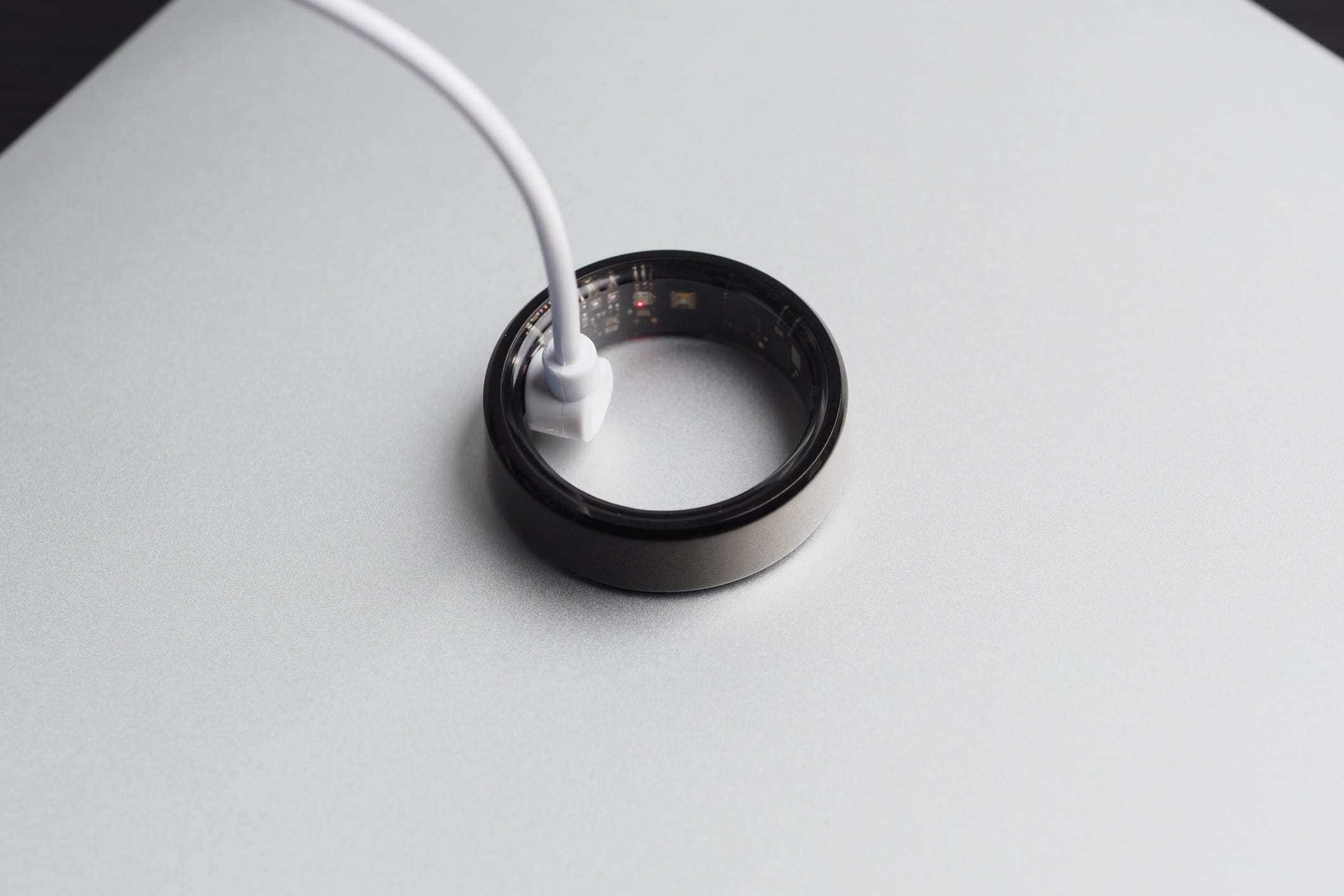Smart rings are emerging as a premium new layer in the wearables ecosystem, offering discreet, screen-light health and wellness tracking that complements smartwatches and bands. Our latest blog explores how this growing category can move beyond niche status to become a strategic cornerstone of connected health and fitness ecosystems.
The global smart ring market has gained remarkable momentum in recent years, with 2025 shaping up as its strongest yet. Omdia estimates that shipments exceeded 850,000 units in 2023, more than doubling to 1.8 million in 2024, and reaching 1.6 million in the first half of 2025. Full-year volume is forecast to hit just over 4 million units, highlighting the category’s rapid rise within the broader wearable ecosystem.
Oura remains the dominant market leader with a 74% share in H1 2025, followed by Ultrahuman (9%), Samsung (9%), and RingConn (5%), with the remainder split among Circular, Noise, boAt, Zepp, and others.
Why Smart Rings Have Grown
Smart rings are among the fastest-growing wearable segments, driven by consumer demand for simpler, all-in-one health solutions and vendors’ ambitions to diversify. It’s a new, exciting category that many tech and wellness enthusiasts have jumped on. At the same time, many users increasingly seek centralized experiences through their smartphones: fewer screens, fewer apps, and fewer distractions, while still receiving continuous health tracking, sleep monitoring, and actionable insights. A 2024 Omdia consumer study found that nearly half of European consumers feel they spend too much time on screens, especially younger users concerned about digital fatigue. Smart rings designed for simplicity and seamless functionality effectively meet these needs.
The 2025 iteration of the survey showed that 43% of respondents did not own a wearable band, and 51% of this group had no plans to buy one. Discomfort from wearing a watch all day or overnight, coupled with frequent charging needs, discourages many from adopting wrist-based devices. Smart rings offer a discreet, comfortable alternative, opening opportunities to engage these untapped users and expand the wearable ecosystem.
Smart rings excel in tracking sleep, stress, recovery, and women’s health. Their superior skin contact and proximity to blood vessels enable more accurate measurements, such as skin temperature, while longer wear times provide a comprehensive health picture compared to wrist devices. Advanced AI interprets subtle physiological changes, identifies early signs of stress, fatigue, or illness, and offers personalized coaching and reliable menstrual and fertility predictions.
Rather than competing with existing wearables, smart rings complement them. Rings typically focus on continuous wellness and sleep tracking, while watches monitor activity and fitness. Together, they deliver a more comprehensive health picture, enhancing the value of a vendor’s ecosystem. Leading players are exploring multi-device models, such as Apple’s Watch and AirPods, Samsung’s Galaxy Watch and Ring, and Ultrahuman’s expanding health monitoring technologies aiming to create a holistic health and fitness ecosystem. True cross-device intelligence is still emerging, limited by sensor optimization challenges and battery constraints, but investments in AI and R&D are enabling devices to work together more effectively. As ecosystems mature, the integration of edge-cloud AI will allow combined data streams to provide deeper, predictive insights, strengthening user engagement and platform differentiation.
Smart Ring Monetization and Revenue Models
Smart rings offer a distinct monetization approach. Unlike multi-functional smartwatches, their narrow focus allows vendors to offer subscription-based or premium services tied directly to insights. Oura exemplifies this, reinvesting subscription revenue into R&D to deliver regular software updates, new metrics, and performance improvements. Subscriptions have enabled features like GenAI personal coaching, Symptom Radar, and Stress Management Tools. Funding rounds, such as Oura’s $900 million raise at an $11 billion valuation, reinforce continued innovation and the sustainability of subscription models. Clear value propositions make subscriptions attractive, and the accumulation of personalized health data compounds user value, incentivizing loyalty. Sustained success will depend on demonstrating continuous, personalized value and deep ecosystem integration. However, another major tech vendor offering a one-time purchase could disrupt this model.
Expanding Smart Ring Market Adoption
Smart rings remain a premium niche, and expanding their appeal requires clear, compelling communication of value. Vendors must educate consumers on how these devices enhance health and wellness - leveraging social media, influencer partnerships, and in-person experiences to build awareness and trust. Exploring new distribution channels such as fashion retailers, pharmacies, and dedicated retail displays can further increase visibility and accessibility.
Key Challenges for Smart Ring Growth
A concentrated market with a clear leader also creates an opening for an established device vendor to disrupt the category with a standout product and a bold, innovative go-to-market strategy. Now is the time to invest and capture consumer imagination while the category’s momentum is building and before Oura further solidifies its dominance. The market is on track for rapid expansion, and the premium positioning of smart rings already places their total market value at an impressive level relative to current shipment volumes. If new entrants or the next generation of incumbents can address the key challenges outlined below, smart rings have the potential to reinvigorate the broader wearable market and redefine the future of personal health technology:
- Hardware and performance limitations: Small form factors constrain sensors, antennas, and battery size. Innovation in software and AI-driven insights remains critical.
- Durability and comfort: Bulky designs can feel uncomfortable, and finger size changes affect both fit and sensor accuracy.
- Price and adoption: High costs hinder mass-market adoption; tiered pricing and ongoing innovation are necessary.
- Battery reliability: Long-lasting, safe, and dependable power is key to mainstream acceptance.
- Fitness tracking accuracy: Activity detection and sport metrics require improvement to broaden appeal.
- Data ownership and privacy: Cloud storage introduces vulnerability, demanding strong security and transparent practices, particularly for emerging players.
Smart Rings in an Integrated Health Ecosystem
Their true potential lies in cross-device ecosystems: rings, watches, earbuds, and smartphones working together to create holistic health insights. Generative AI will transform raw metrics into actionable, personalized recommendations, anticipating rest needs, flagging early illness, and optimizing recovery.
By offering more accurate and continuous metrics than wrist-based devices, smart rings can enhance sleep, stress, and wellness tracking. Combined with predictive insights and ecosystem integration, they provide sustained value, foster brand loyalty, and justify premium pricing. Smart rings are not positioned to replace other wearables but to complement them, offering a seamless, passive layer of intelligence. With continued progress in hardware, software, and AI, smart rings could define the next wave of proactive health ownership. Tomorrow’s smaller and smarter rings will be seamlessly integrated into daily life.
To read more insights and analysis on the smart ring market prepared by Omdia, click here.
More from author
More insights
Assess the marketplace with our extensive insights collection.
More insightsHear from analysts
When you partner with Omdia, you gain access to our highly rated Ask An Analyst service.
Hear from analystsOmdia Newsroom
Read the latest press releases from Omdia.
Omdia NewsroomSolutions
Leverage unique access to market leading analysts and profit from their deep industry expertise.
Solutions









